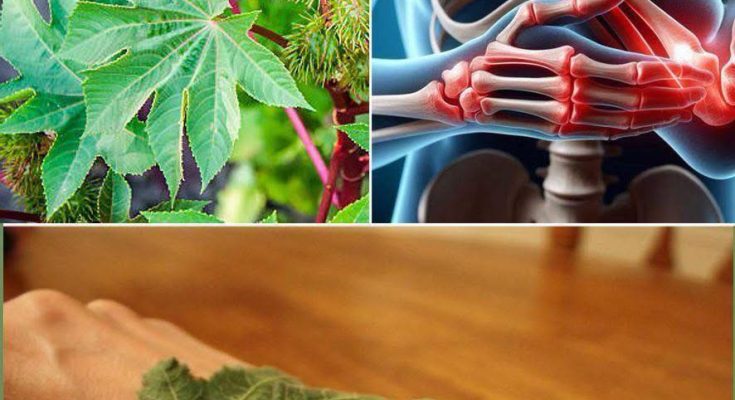🌿 The Powerful Benefits of Castor Leaves You Probably Didn’t Know About
When people hear “castor,” they usually think of castor oil, long known for its powerful laxative effect and skin-healing properties. However, castor leaves—the large, palmate leaves of the Ricinus communis plant—have their own impressive set of health benefits that are often overlooked. Used for centuries in traditional medicine across Africa, Asia, and Latin America, castor leaves are now gaining recognition for their natural healing power.
In this article, we’ll explore the hidden medicinal properties of castor leaves, how to use them safely, and why they deserve a spot in your natural remedy toolkit.
🌱 What Are Castor Leaves?
Castor leaves come from the Ricinus communis plant, a fast-growing perennial shrub native to Africa and India. The plant produces the famous castor seeds (from which the oil is extracted), but its leaves are also rich in bioactive compounds, including:
-
Ricinine (alkaloid)
-
Flavonoids
-
Tannins
-
Terpenoids
-
Saponins
These compounds are responsible for the leaves’ wide range of anti-inflammatory, antimicrobial, analgesic, and healing properties.
🩺 Traditional Uses of Castor Leaves
For generations, cultures around the world have used castor leaves in herbal remedies to treat:
-
Joint and muscle pain
-
Inflammation
-
Skin wounds and infections
-
Digestive discomfort
-
Respiratory conditions
-
Fever and headaches
-
Swollen lymph nodes
-
Breast pain or swelling (especially during lactation)
🔬 Modern Research and Evidence
Scientific studies now back many of these traditional uses. Research has found that castor leaf extracts demonstrate:
-
Strong anti-inflammatory effects in arthritic models
-
Antibacterial activity against common pathogens
-
Wound healing acceleration due to enhanced collagen production
-
Analgesic effects comparable to over-the-counter pain relief
-
Antioxidant activity that helps reduce cellular damage
💪 Top Health Benefits of Castor Leaves
1. Relieves Joint and Muscle Pain
Castor leaves can be applied as a hot compress or poultice to areas with arthritis, back pain, or sore muscles. The natural anti-inflammatory agents penetrate the skin and ease discomfort.
✅ Often used in Ayurvedic and African medicine for rheumatism.
2. Promotes Wound Healing
Fresh castor leaves, when applied to cuts, burns, insect bites, or ulcers, accelerate healing and reduce the risk of infection due to their antibacterial and skin-regenerating effects.
🩹 The leaves act like a natural bandage.
3. Reduces Swelling and Inflammation
Whether it’s post-surgery swelling, swollen lymph nodes, or inflammation from trauma, wrapping the affected area with warmed castor leaves can significantly reduce puffiness and pain.
4. Supports Breastfeeding Mothers
Castor leaves are traditionally placed on swollen or engorged breasts to reduce inflammation and pain, improving comfort and milk flow during breastfeeding.
🍼 A natural and safe remedy for lactating women (used externally).
5. Respiratory Support
Used in teas or chest compresses, castor leaves may help relieve coughs, bronchial congestion, and asthma. The expectorant properties help clear mucus and reduce chest tightness.
6. Antibacterial and Antifungal Effects
Topical application of castor leaf extract can help treat skin infections, fungal growth, and acne. The antimicrobial compounds inhibit the growth of several harmful microbes.
7. Digestive Relief
Although not commonly consumed, teas made from dried castor leaves are used in traditional medicine to ease bloating, stomach cramps, and detoxify the digestive system.
⚠️ Note: Internal use should be supervised, as the plant contains strong compounds.
🌿 How to Use Castor Leaves Safely
✅ External Uses:
-
Poultice/Compress: Warm fresh leaves slightly, coat with castor oil, apply to the affected area, and cover with cloth. Leave for 30–60 minutes.
-
Topical application: Mash fresh leaves into a paste and apply to wounds or sore joints.
-
Steam Inhalation: Boil leaves and inhale steam to relieve respiratory symptoms.
☕ Internal Use (Caution!):
-
Only small amounts of dried leaf tea under professional guidance.
-
Avoid if pregnant, breastfeeding (for internal use), or in children under 12.
⚠️ Warnings and Contraindications
-
Toxicity risk from seeds: Never use castor seeds internally—only leaves and oil are used medicinally.
-
Allergic reactions: Perform a patch test before topical use.
-
Pregnancy: Avoid internal use. External compresses may be allowed under supervision.
-
Dosage control: Overuse of any herbal remedy can lead to complications—always use with caution.
💬 Real-Life Testimonials
“I used castor leaf compresses for my swollen knee, and the pain reduced within hours.” – Maria G.
“My grandmother always wrapped my chest with warm castor leaves whenever I had bronchitis. It always worked better than Vicks!” – Carlos R.
“I struggled with mastitis while nursing, and warm castor leaves gave me relief in a natural way.” – Lucia M.
🌍 Castor Leaves in Global Traditions
-
India (Ayurveda): Applied to joints, breasts, and wounds
-
Nigeria & Ghana: Used for fever, pain, infections
-
Latin America: Applied for chest congestion, arthritis, and inflammation
📌 Conclusion: A Forgotten Healing Treasure
While castor oil has earned global fame, castor leaves remain one of the most underrated healing gifts from nature. With their potent anti-inflammatory, analgesic, and antimicrobial properties, they offer natural relief for common ailments—from sore joints to skin issues and beyond.
As always, use plant-based remedies responsibly and seek guidance from a knowledgeable practitioner when in doubt.



